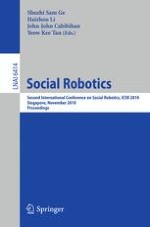The papers in this volume were the fruitful scientific results of the Second International Conference on Social Robotics (ICSR), held during November 23–24, 2010 in Singapore, which was jointly organized by the Social Robotics Laboratory (SRL), Interactive Digital Media Institute (IDMI), the National University of Singapore and 2 Human Language Technology Department, the Institute for Infocomm Research (I R), A*STAR, Singapore. These papers address a range of topics in social robotics and its applications. We received paper submissions from America, Asia, and Europe. All the papers were reviewed by at least three referees from the 32-member Program Committee who were assembled from the global community of social robotics researchers. This v- ume contains the 42 papers that were selected to report on the latest developments and studies of social robotics in the areas of human––robot interaction; affective and cognitive sciences for interactive robots; design philosophies and software archit- tures for robots; learning, adaptation and evolution of robotic intelligence; and mec- tronics and intelligent control.
